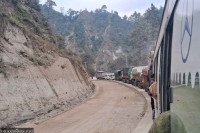Editorial
Watering grassroots
Nepal can’t develop without improving the status of its villages, including on service delivery.
Developing infrastructure in remote parts of Nepal has historically been a neglected issue. Things were expected to improve after the introduction of the federal system. The new system came into full-fledged implementation after the first elections of federal, provincial and local units in 2017. One of the major objectives for adopting the federal system was to devolve powers to sub-national governments and strengthen them in terms of easing people’s daily lives, cutting red tape and taking state facilities closer to their doorsteps. After seven years of execution of the three-tier federal system, the sub-national authorities, however, couldn’t bring about expected improvement—bar some exceptions.
Even now people in far-flung villages across the country are compelled to struggle for basic facilities. A recent report from our local correspondent in Panchthar narrates the plight of Hilihang villagers’s struggles for drinking water due to acute water shortage. People there have to make an hour-long journey to fetch water. On Monday, a report from Achham offered a glimpse of people’s struggle even to draw their social security allowances: the government provides certain amounts to single women, elderly and disabled on a monthly basis to help with their livelihoods. But folks in remote villages including those from the Turmakhand Rural Municipality have to trek for up to three days to reach the administrative centre of the rural municipality to collect their allowances. These representative cases show how people in Nepal’s villages are falling far behind in terms of enjoying even basic amenities.
Nepal can’t develop without improving the status of its villages. Of the 753 local units, 460 are rural municipalities, 276 are municipalities, 11 sub-metropolitan and six are metropolitan cities. This classification shows the vast majority of our local units are still poor in infrastructure. To lift the status of people in the villages, the first need is to ensure roads, telephone and internet connectivity, which are basic needs in this day and age—besides the all-important facilities like health, education and drinking water
Elderly people in Turmakhand of Achham district need to trek for days to reach the municipality’s administrative centre to get their allowances. Often, the municipalities centralise most facilities at the administrative centres. In many local units, a ward now covers an area that used to be an entire village development committee (VDC), a local body before adoption of the federal system. So, in terms of providing basic services, wards should be developed as a base station and be better equipped, resourceful and efficient to accomplish basic tasks on their own.
The local units too need to explore alternatives to help people get quick and efficient services. For instance, they can mobilise mobile government teams, comprising officials from all agencies concerned, to tour villages and provide allowances and other services periodically. This in turn calls for better planning and coordination among local administrations. Moreover, provincial governments and representatives need to work harder in terms of making service delivery more efficient as well. Such initiatives have become imperative to retain people in the fast-emptying villages across the country due to the increasing trend of internal as well as external migration.




 16.57°C Kathmandu
16.57°C Kathmandu














